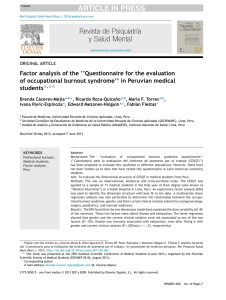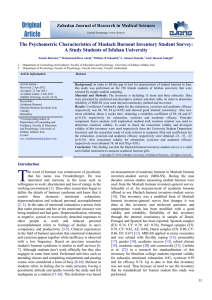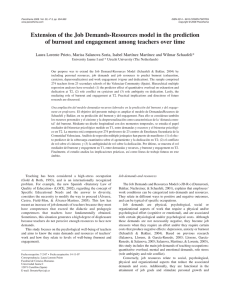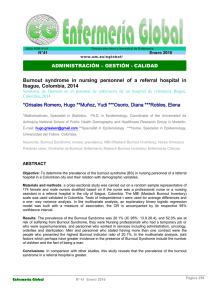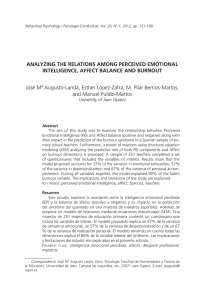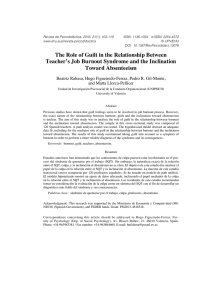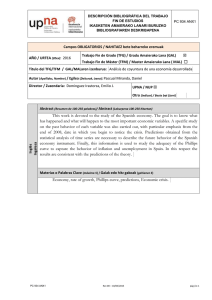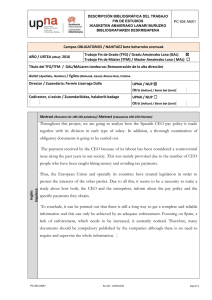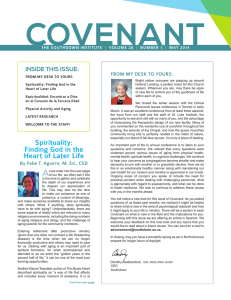Working in direct contact with the public as a predictor
Anuncio
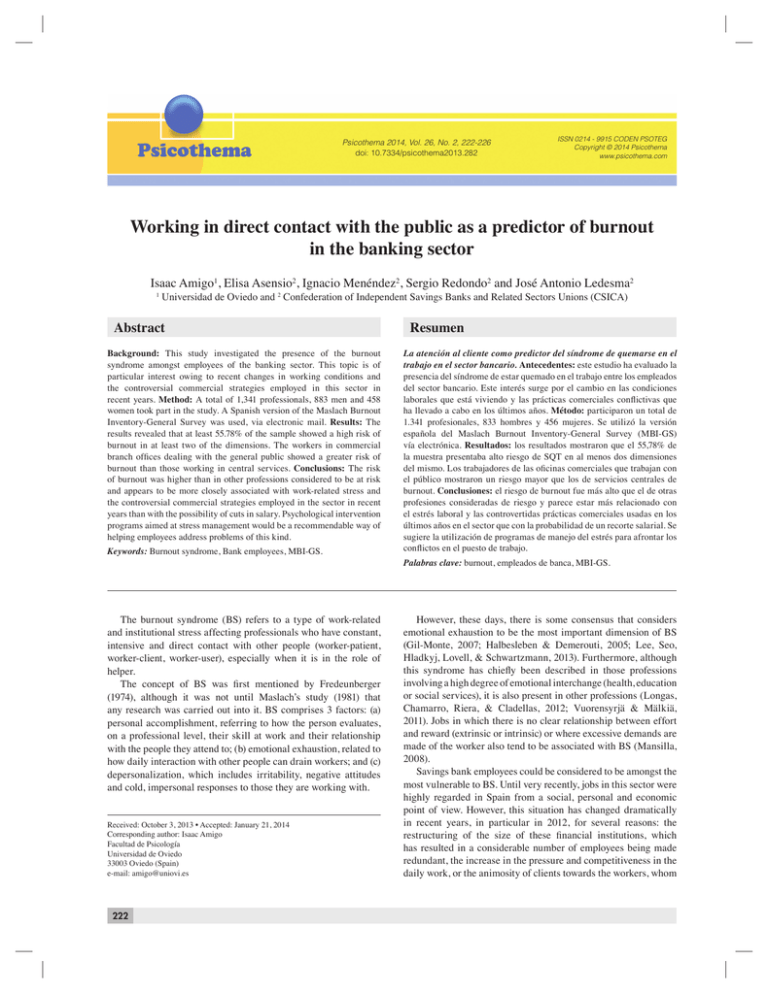
Isaac Amigo, Elisa Asensio, Ignacio Menéndez, Sergio Redondo and José Antonio Ledesma Psicothema 2014, Vol. 26, No. 2, 222-226 doi: 10.7334/psicothema2013.282 ISSN 0214 - 9915 CODEN PSOTEG Copyright © 2014 Psicothema www.psicothema.com Working in direct contact with the public as a predictor of burnout in the banking sector Isaac Amigo1, Elisa Asensio2, Ignacio Menéndez2, Sergio Redondo2 and José Antonio Ledesma2 1 Universidad de Oviedo and 2 Confederation of Independent Savings Banks and Related Sectors Unions (CSICA) Abstract Background: This study investigated the presence of the burnout syndrome amongst employees of the banking sector. This topic is of particular interest owing to recent changes in working conditions and the controversial commercial strategies employed in this sector in recent years. Method: A total of 1,341 professionals, 883 men and 458 women took part in the study. A Spanish version of the Maslach Burnout Inventory-General Survey was used, via electronic mail. Results: The results revealed that at least 55.78% of the sample showed a high risk of burnout in at least two of the dimensions. The workers in commercial branch offices dealing with the general public showed a greater risk of burnout than those working in central services. Conclusions: The risk of burnout was higher than in other professions considered to be at risk and appears to be more closely associated with work-related stress and the controversial commercial strategies employed in the sector in recent years than with the possibility of cuts in salary. Psychological intervention programs aimed at stress management would be a recommendable way of helping employees address problems of this kind. Keywords: Burnout syndrome, Bank employees, MBI-GS. Resumen La atención al cliente como predictor del síndrome de quemarse en el trabajo en el sector bancario. Antecedentes: este estudio ha evaluado la presencia del síndrome de estar quemado en el trabajo entre los empleados del sector bancario. Este interés surge por el cambio en las condiciones laborales que está viviendo y las prácticas comerciales conflictivas que ha llevado a cabo en los últimos años. Método: participaron un total de 1.341 profesionales, 833 hombres y 456 mujeres. Se utilizó la versión española del Maslach Burnout Inventory-General Survey (MBI-GS) vía electrónica. Resultados: los resultados mostraron que el 55,78% de la muestra presentaba alto riesgo de SQT en al menos dos dimensiones del mismo. Los trabajadores de las oficinas comerciales que trabajan con el público mostraron un riesgo mayor que los de servicios centrales de burnout. Conclusiones: el riesgo de burnout fue más alto que el de otras profesiones consideradas de riesgo y parece estar más relacionado con el estrés laboral y las controvertidas prácticas comerciales usadas en los últimos años en el sector que con la probabilidad de un recorte salarial. Se sugiere la utilización de programas de manejo del estrés para afrontar los conflictos en el puesto de trabajo. Palabras clave: burnout, empleados de banca, MBI-GS. The burnout syndrome (BS) refers to a type of work-related and institutional stress affecting professionals who have constant, intensive and direct contact with other people (worker-patient, worker-client, worker-user), especially when it is in the role of helper. The concept of BS was first mentioned by Fredeunberger (1974), although it was not until Maslach’s study (1981) that any research was carried out into it. BS comprises 3 factors: (a) personal accomplishment, referring to how the person evaluates, on a professional level, their skill at work and their relationship with the people they attend to; (b) emotional exhaustion, related to how daily interaction with other people can drain workers; and (c) depersonalization, which includes irritability, negative attitudes and cold, impersonal responses to those they are working with. Received: October 3, 2013 • Accepted: January 21, 2014 Corresponding author: Isaac Amigo Facultad de Psicología Universidad de Oviedo 33003 Oviedo (Spain) e-mail: [email protected] 222 However, these days, there is some consensus that considers emotional exhaustion to be the most important dimension of BS (Gil-Monte, 2007; Halbesleben & Demerouti, 2005; Lee, Seo, Hladkyj, Lovell, & Schwartzmann, 2013). Furthermore, although this syndrome has chiefly been described in those professions involving a high degree of emotional interchange (health, education or social services), it is also present in other professions (Longas, Chamarro, Riera, & Cladellas, 2012; Vuorensyrjä & Mälkiä, 2011). Jobs in which there is no clear relationship between effort and reward (extrinsic or intrinsic) or where excessive demands are made of the worker also tend to be associated with BS (Mansilla, 2008). Savings bank employees could be considered to be amongst the most vulnerable to BS. Until very recently, jobs in this sector were highly regarded in Spain from a social, personal and economic point of view. However, this situation has changed dramatically in recent years, in particular in 2012, for several reasons: the restructuring of the size of these financial institutions, which has resulted in a considerable number of employees being made redundant, the increase in the pressure and competitiveness in the daily work, or the animosity of clients towards the workers, whom Working in direct contact with the public as a predictor of burnout in the banking sector they blame for having sold financial products which have led to substantial losses for many clients. This has created an atmosphere of susceptibility amongst bank employees, leading to an increase in the stress in their working environment and, in particular, to an increased tendency to feel burnout. To date, no significant research has been carried out into the presence of BS in this sector, making it very difficult to evaluate its evolution over time amongst this particular group of workers. This is the first large-scale study to be carried out in this sector. One of its specific aims is to evaluate the differences between employees who work in commercial branch offices, dealing with the general public, and those who work in central services, as it is the former who have been the target of customers’ complaints regarding high-risk commercial practices in recent years. Method Participants A total of 1,341 professionals from all the Spanish Savings Banks took part in this study. 883 were men (65.85% of the sample) and 458 were women (34.15% of the sample). The number of professionals who worked in branch offices and had direct contact with the clients was 1130 (84.27%) whilst the number of workers in central services was 211 (15.73%). This sample represents slightly over 1% of the total number of employees in Spanish Savings Banks, which was the percentage of workers who answered the questionnaire. Instruments In order to evaluate the BS, the Maslach Burnout InventoryGeneral Survey (MBI-GS) was used (Schaufeli, Leiter, Maslach, & Jackson, 1996). This version of Maslach’s original survey is designed to measure BS in all types of jobs, regardless of the type of tasks carried out, and consequently seemed more suitable when evaluating professionals who do not have such direct contact with other people as may be the case with teachers, doctors or police officers. The adapted Spanish version of this instrument used in this study was created by Salanova, Schaufeli, Llorens, Grau and Peiró (2000) and published by the Ministry of Work and Social Services through the Institute for Safety and Hygiene in its Technical Note of Prevention NTP 732. The questionnaire was sent via electronic mail. The survey consists of 15 items to be answered using a Likerttype frequency scale ranging from 0 (never) to 6 (always). In this adaptation, a more recent terminology was adopted for two of the BS factors. Depersonalization was renamed “Cynicism” and “Personal Accomplishment” was changed to “Professional Efficacy.” High scores in the Exhaustion dimension (4 items) and in the Cynicism dimension (5 items) together with low scores in Professional Efficacy (6 items) will be indicators of BS. The scores for each dimension are obtained by adding together the scores obtained in each of the items belonging to each scale and dividing the result by the number of items in the scale. The internal consistency of the questionnaire is good. Cronbach’s alpha for each of the factors was, respectively: Exhaustion, .87, Cynicism, .85 and Professional Efficacy, .78. These psychometric data correspond to those obtained when the questionnaire was originally validated. The participants were also asked to provide sociodemographic data regarding sex, age and years of service. Procedure The survey was aimed at workers of those banks deriving from the former Savings Banks that are functioning in Spain. The survey was distributed using electronic mail to the unions and federated unions making up the CSICA (Confederation of Independent Savings Banks and Related Sectors Unions), which operates all over Spain in order that they, in turn, could send them to the workers using those means made available to them by the banks. The survey was carried out through the link www. fundaciondeas.es, a page corresponding to the DEAS foundation, thus guaranteeing the total anonymity of all those participating in the project, the correct functioning of the computerized process and an accurate calculation of the various descriptive values. All the participants had to do was to access the aforementioned link and fill in the questionnaire. Data analysis A descriptive analysis of the results was carried out for the three dimensions which make up the MBI-GS, including the calculation of the percentages of workers with low, medium and high levels according to the assessment scales for the questionnaire (Salanova et al., 2000). In order to ascertain the prevalence of BS in the population studied, a restrictive criterion was used and only those who had high scores in at least two of the three dimensions of the questionnaire were taken into account. The scoring scales included in the questionnaire were used to define what was considered to be a high score in each of the dimensions. Descriptive data showing the evolution of the BS dimensions according to both the age, gender and the years of service of the participants are also given. Variance analysis and Tukey’s test were used to evaluate the effect of age and years of service on each of the BS dimensions. A stepwise regression analysis was carried out to determine which of the studied variables (age, sex, workplace or years of service) would predict a high score in each of the MBI scales. Results Table 1 shows the values indicating the level of BS in the MBIGS for Savings Bank workers. According to the assessment scales for the questionnaire, 3 levels can be distinguished: high, medium and low. Of the participants, 63.16% showed high-risk levels for Emotional Exhaustion; 60.92% of the sample scored high in Cynicism and 28.41% scored low in Professional Efficacy. Table 1 Risk level for each of the factors of the MBI-GS for Savings Bank workers Level risk Low Medium High N % N % N % Exhaustion 167 12.45 327 24.38 847 63.13 Cynicism 149 11.11 375 27.96 817 60.92 Efficacy 390 29.90 570 42.51 381 28.41 223 Isaac Amigo, Elisa Asensio, Ignacio Menéndez, Sergio Redondo and José Antonio Ledesma More detailed factor analysis (Table 2) showed that 77.78% of the sample subjects showed high-risk levels in only one dimension, 55.78% of the sample had high risk in two dimensions and 18.94% of the subjects had high risk levels in all three dimensions of the MBI. The most frequent combination of BS factors was Emotional Exhaustion and Cynicism, observed in 50.48% of the sample and far higher than the other possible combinations. With regard to comparison according to gender (Table 3), significant differences can be observed in Emotional Exhaustion (p<.002) and in Professional Efficacy (p<.025). Women scored higher than men in Emotional Exhaustion and men scored lower than women in Professional Efficacy. With regard to place of work, the sample was divided into two groups: Central Services (N = 211) made up of workers not working with the general public and Offices (N = 1120) made up of those participants who work in the branch offices of the banks (Table 4). Significant differences can be observed between the two groups in all three dimensions. Emotional Exhaustion (p<.001), Cynicism (p<.001) and Professional Efficacy (p<.001). The branch office workers scored higher in Emotional Exhaustion and Cynicism and lower in Professional Efficacy. The effect sizes of these differences, calculated using Cohen’s d, were .527 for Emotional Exhaustion, .341 for Cynicism and .238 for Professional Efficacy Table 2 High risk level in the three factors of the MBI-GS % Total % Men % Women 19.87 On the 3 scales 18.94 18.46 At least 2 55.78 54.93 57.42 At least 1 77.78 78.48 76.42 None 22.22 21.52 23.58 Note: 55.78% of the sample had high risk of suffering BS Table 3 Comparison between men and women in the three dimensions of BS Exhaustion Women Men Cynicism Efficacy Mean SD Mean SD Mean SD 3.72 1.73 3.11 1.82 4.47 1.02 1.70 3.06 1.83 4.34 3.43 p * ns 1.12 ** In order to compare the effect of age on the scores in the BS scales, the sample was divided into four age groups and a variance analysis was carried out for each of the scales. 245 subjects were under the age of 35, 457 were between the ages of 36 and 45, 473 were between the ages of 46 and 54 and 166 were over 55. In the case of Emotional Exhaustion significant differences were observed, F(3,133) = 3.39, MSE = 2.95, p<.018. In the post hoc analysis using Tukey’s test, the over-55 age group showed less emotional exhaustion than the 46-54 age group (p<.05). Differences were also observed in the Cynicism scale, F(3,133) = 4.03, MSE = 3.34, p<.007 and once again the over-55 group scored lower on this scale than the 45-54 age group (p<.01). In the Efficacy scale, significant differences were also observed, F(3,133) = 7.41, MSE = 1.18 p<.001.In this case it was the under-35 age group who felt they were professionally more efficient than the 36-45 group (p<.05), the 46-54 group (p<.01) and the over-55 group (p<.01). In order to compare the effect of years of service on the scores of the BS scales, the sample was divided into four groups according to years of service, and a variance analysis was carried out for each scale. Significant differences were observed in the case of Emotional Exhaustion, F(3,133) = 3.69, MSE = 2.95, p<.012. The post hoc analysis using Tukey’s test showed no differences between groups. Differences were also observed in the Cynicism scale, F(3,133) = 6.42, MSE = 3.33, p<.001. Once again, the group with more than 30 years of service had significantly lower scores on the Cynicism scale than the group with between 0 and 10 years of service (p<0.01), than the group with 11 to 20 years of service (p<.01) and than the group with 21-30 years of service (p<.01). The F-value was significant in the case of Professional Efficacy, F(3,133) = 5.31, MSE = 1.17, p<.001. The post hoc analysis indicated that those workers with less than 10 years of service scored higher on the Efficacy scale than the other three groups: 11-20 years (p<.05), 21-30 years (p<.01) and more than 30 years of service (p<.01). The stepwise regression analysis that was carried out to determine the variables that would predict the high score values in the MBI scales (Table 5) revealed that working in the branch offices predicted greater emotional exhaustion, F(2,133) = 29.473, p<.001; lower professional efficacy (F(2,133) = 17.231, p<.001) and greater cynicism (F(2,133 ) = 14.178, p<.001). Discussion This study revealed a high degree of BS amongst employees of Spanish Savings Banks. 55.78% of the more than 1,300 workers Note: Differences between groups at the p<.002* and p<.025** Table 5 Results of regression analysis for the MBI dimensions Table 4 Comparison of the dimensions of BS according to place of work Predictors Exhaustion Mean SD Cynicism Mean SD Mean Branch office 3.67 1.69 3.18 1.81 4.34 Central Services 2.78 1.67 2.56 1.85 4.60 p * Note: Differences between groups at the p<.001 224 * R2 β F Efficacy Exhaustion Workplace Sex .037 .042 -.894 .273 29.473*** Efficiency Workplace Age .016 .025 -.017 .288 17.231*** Cynicism Workplace Age of service .016 .021 -.622 -.013 14.178*** SD 1.07 1.19 * *** = p<.001 Working in direct contact with the public as a predictor of burnout in the banking sector studied, representing 1% of the total number of employees of these financial institutions, showed a high risk of suffering from this syndrome. These figures are especially striking as, until recently, jobs in this sector were considered, from a social point of view, to be very desirable. The high prevalence of BS found is even higher than that revealed in other studies involving professions which are systematically associated with this syndrome. In this respect, Longas et al. (2012) reported 20.1% amongst teachers in state-subsidized education; Hernández, Fernández, Ramos and Contador (2006) found 43.6% amongst prison personnel; Aguayo, Vargas and Cañadas (2013) calculated 32.2% amongst the police; Heinke, Dunkel, Brähler, Nübling, Riedel-Heller and Kaisers (2011) detected 40.1% amongst doctors and Heinke et al. (2011) detected 33.25% amongst the population in general. The high incidence of BS revealed in this study is even more relevant if one considers that the criteria used when establishing the risk in the sample was very restrictive, as only those workers with high scores in at least two factors of the MBI-GS were taken into account. Furthermore, the usual evaluation procedure for studying this syndrome was used, consisting of sending the questionnaire to a particular population and analysing the results using the data of the participants who fill out that questionnaire. Analysis of the combinations of MBI-GS factors in which the participants’ scores showed a high risk revealed that the most frequent risk combination was that of emotional exhaustion and cynicism (50.48%), followed by cynicism and professional efficacy (22.22%) and emotional exhaustion and professional efficacy (20.95%). The factor for which the greatest number of workers showed a high risk of BS was emotional exhaustion. The results appear to be coherent with those obtained by other studies in which emotional exhaustion is identified as the core dimension of the syndrome (Gil-Monte, 2007; González-Romá, Schaufeli, Bakker, & Lloret, 2006; Halbesleben & Demerouti, 2005; Lee et al., 2013). The effect of age and years of service on BS has been reported in the literature (Gil-Monte, 2005; Hernández et al., 2006; Longas et al., 2012). In line with this, in this study, those of over 54 years of age and those with over 30 years of service had significantly lower scores in Emotional Exhaustion and Cynicism than the rest of the groups. This fact is usually interpreted as being a result of the development of coping skills and of an adjustment of professional expectations over the years. Another element could be added to this. Savings Bank workers in this age group have fewer uncertainties about their working future, given that this can be resolved by resorting to early retirement. It is also interesting to note that it was the younger workers, under the age of 35 and with less than 10 years of service, who had significantly higher scores than the rest of the groups in professional efficacy. This could be a result not only of their drive and initial enthusiasm for the job but also of their better and more comprehensive skills in the use of computer programs. These younger workers have been brought up alongside the new technologies whilst the older workers have had to adapt to them in the course of their careers. Analysis of the differences according to sex showed that women with BS suffer from a greater degree of emotional exhaustion than men. This is consistent with the literature (Ayuso & Guillen, 2008; Heinke et al., 2011). No differences between men and women were revealed with regard to cynicism. This is inconsistent with the results of (Ríos, Godoy, & Peñalver, 2008; Purvanova & Muros, 2010), which observed a greater degree of cynicism in men. On the other hand, a difference was found in terms of greater professional efficacy in women, which was not normally found in previous studies. These results could possibly be determined by a working context that has undergone profound changes and has become tremendously competitive to a point where what is at stake at work on a daily basis is not simply extra pay but the job itself. A similar interpretation could be made of the substantial differences found between workers in branch offices and those working in central services. The former showed greater emotional exhaustion, greater levels of cynicism and less professional efficacy than the latter. The medium effect size in the cases of emotional exhaustion and cynicism confirmed the relevance of these differences, particularly in these two dimensions. One explanation for this could be found in the original definition of BS, namely that the syndrome is more likely to occur amongst people who work with other people and where there is an emotional exchange between worker and recipient (Maslach, Schaufeli, & Leiter, 2001). Branch office workers come into daily contact with people with serious economic problems, such as the inability to pay certain bills or problems paying the mortgage and they have to deal with these problems. Furthermore, branch workers have had to sell to their customers extremely complicated financial products that have been very problematic and are examples of the extremely competitive practices which these financial institutions have carried out. For branch office employees, all these things have led to a certain loss of control over many aspects of their working lives and could explain their feeling of less professional efficacy and greater emotional exhaustion and cynicism than the employees who work in central services (Alarcon, 2011; Lee, Lim, Yang, & Lee, 2011). The regression analysis confirmed the importance that the workplace has on burnout development. Working in branch offices implies a higher risk of suffering from burnout than working in central services. The critical difference between the two workplaces is that in one, there is contact with the public while in the other, there is not. Other working conditions appear to be the same in both groups. Furthermore, data suggest that pay level is only marginally related to job satisfaction (Judge, Piccolo, Podsakoff, Shaw, & Rich, 2010) and both groups are equally affected by the possibility of salary reduction or layoff. These results suggest that burnout could be more related to daily interpersonal stress at work, provoked by the controversial commercial strategies used in the sector in recent years than with the probability of layoff or salary reduction. Nahrgang, Morgeson and Hofmann (2011) found that job demands such as risks, hazards and complexity impair employees’ health and positively relate to burnout. Moreover, demands that employees tend to appraise as hindrances are negatively associated with engagement and job satisfaction (Crawford, Lepine, & Rich, 2010; Figueiredo, Grau, Gil, & García, 2012). A more detailed study of this question could confirm this interesting result. The fact that there are no previous studies regarding burnout in the banking sector may account for the lack of awareness of the problem which has existed until now. The change in the working atmosphere in branch banks has occurred in the last few years. Previously, conflicts with the clients were far less probable. Since there is a connection between high levels of worker burnout and a decrease in work effectiveness and an increase in absenteeism (Petita & Veccione, 2011), these results open the 225 Isaac Amigo, Elisa Asensio, Ignacio Menéndez, Sergio Redondo and José Antonio Ledesma door to the development of a specific program of psychological intervention with the members of this group of workers that are affected by their problematic relationships with their clients. Social skills training and conflict resolution techniques to deal with customers’ complaints without causing a hostile reaction, could be a very useful tool which would allow the workers to gain the necessary control over their daily work (Frost & Robinson, 1999; Boyd, Tuckey, & Winefield, 2013) . Control over one’s work is considered to be a form of protection against stress at work (Endogen, Bauer, Truxillo, & Mansfield, 2012; Pillay, Goodard, & Wilss, 2005). Finally, it should be noted that one of the limitations of this study is that insufficient information was gathered to explain the relationship found between the workplace and burnout. Had the magnitude of this relationship been foreseen, an additional questionnaire could have been used to assess in more detail the differences between working in commercial offices and central services. References Alarcon, G.M. (2011). A meta-analysis of burnout with job demands, resources, and attitudes. Journal of Vocational Behavior, 79, 549-562. Ayuso, J.A., & Guillén, C.L. (2008). Burnout y mobbing en Enseñanza Secundaria [Burnout and mobbing in high school]. Revista Complutense de Educación, 19, 157-173. Boyd, C.M., Tuckey, M.R., & Winefield, A.H. (2013). Perceived effects of organizational downsizing and staff cuts on the stress experience: The role of resources. Stress Health. doi: 10.1002/smi.2495 [Epub ahead of print]. Crawford, E.R., Lepine, J.A., & Rich, B.L. (2010). Linking job demands and resources to employee engagement and burnout: A theoretical extension and meta-analytic test. Journal of Applied Psychology, 95, 834-848. De la Fuente, M., Aguayo, R., Vargas, C., & Cañadas, G. (2013). Prevalence and risk factors of burnout syndrome among Spanish police officers. Psicothema, 25, 488-493. Erdogan, B., Bauer, T.N., Truxillo, D.M., & Mansfield, L. (2012). Whistle while you work: A review of the life satisfaction literature. Journal of Management, 38, 1038-1083. Freudenberger, M. (1974). Staff Burn-out. Journal of Social Issues, 30, 159-166. Frost, P., & Robinson, S. (1999). The toxic handler: Organizational heroand casualty. Harvard Business Review,77, 96-106. Figueiredo, H., Grau, P., Gil, P.R., & García, J.A. (2012). Síndrome de quemarse por el trabajo y satisfacción laboral en profesionales de enfermería. Psicothema, 24, 271-276. Judge, T.A., Piccolo, R.F., Podsakoff, N.P., Shaw, J.C., & Rich, B.L. (2010). The relationship between pay and job satisfaction: A meta-analysis of the literature. Journal of Vocational Behavior, 77, 157-167. Gil-Monte, P. (2005). El síndrome de quemarse por el trabajo [The burnout syndrome]. Madrid: Pirámide. Gil-Monte, P. (2007). El síndrome de quemarse por el trabajo (burnout): una perspectiva histórica [The burnout syndrome: A historical perspective]. En P. Gil-Monte y B. Moreno (Eds.): El síndrome de quemarse por el trabajo(burnout). Grupos profesionales de riesgo [Burnout síndrome. Professional risk groups] (pp. 21-39). Madrid: Pirámide. González-Romá, V., Schaufeli, W.B, Bakker, A.B., & Lloret, S. (2006). Burnout and work engagement: Independent factors or opposite poles? Journal of Vocational Behavior, 68, 165-174. Halbesleben, J.R., & Demerouti, E. (2005). The construct validity of an alternative measure of burnout: Investigating the English translation of the Oldenburg Burnout Inventory. Work and Stress, 19, 208-220. Heinke, W., Dunkel, P., Brähler, E., Nübling, M., Riedel-Heller, S., & Kaisers, U.X. (2011). Burnout in anesthesiology and intensive care: Is there a problem in Germany? Der Anaesthesist, 60, 1109-1118. Hernández, L., Fernández, B., Ramos, F., & Contador, I. (2006). El síndrome de burn-out en funcionarios de vigilancia de un centro penitenciario [The burn-out syndrome in prison officers]. Interntional Journal of Clinical and Health Psychology, 6, 599-611. Lee, J., Lim, N., Yang, E., & Lee, S.M.(2011). Antecedents and consequences of three dimensions of burnout in psychotherapists: A meta-analysis. Professional Psychology: Research and Practice, 42, 252-258. 226 Lee, R.T., Seo, S., Hladkyj, S., Lovell, B.L., & Schwartzmann, L. (2013). Correlates of physician burnout across regions and specialties: A meta-analysis. Human Resources for Health, 11, 48-90. Longas, J., Chamarro, A., Riera, J., & Cladellas, R. (2012). La incidencia del contexto interno docente en la aparición del Síndrome del Quemado por el Trabajo en profesionales de la enseñanza [The impact of the internal teaching context on the development of burnout syndrome in teaching professionals]. Revista de Psicología del Trabajo y de las Organizaciones, 28, 107-118. Mansilla, F. (2008). Manual de riesgos psicosociales en el trabajo: teoría y práctica [Manual of psychosocial risks at work: Theory and practice]. Retrieved from http://www.psicologia-online.com/ebooks/riesgos/ index.shtml. Maslach, C. (1981). Burnout: Asocial psychological analysis. En J. Jones (Ed.), The burnout syndrome (pp. 227-251). California: Berkely University of California. Maslach, C., Schaufeli, W.B., & Leiter, M.O. (2001). Job burnout. Anual Review of Psychology, 52, 397-422. Ministerio de Trabajo y Asuntos Sociales. Nota Técnica de Prevención NTP 732 Síndrome de estar quemado por el trabajo “Burnout” III. Instrumento de medición [Ministry of Work and Social Affairs. Technical Note of Prevention TNP 732. Prevention of “Burnout” III. Assessment Instrument]. Retrieved from www.insht.es/InshtWeb/ Contenidos/.../NTP/Ficheros/.../ntp_732.pdf. Nahrgang, J.D., Morgeson, F.P., & Hofmann, D.A. (2011). Safety at work: A meta-analytic investigation of the link between job demands, job resources, burnout, engagement, and safety outcomes. Journal of Applied Psychology, 96, 71-94. Petita, L., & Veccione, M. (2011). Job burnout, absenteeism, and extra role behaviors. Journal of Workplace Behavioral Health, 26, 97-121. Pillay, H.K., Goddard, R., & Wilss, L.A. (2005). Well-being, burnout and competence: Implications for teachers. Australian Journal of Teacher Education, 30, 22-33. Purvanova, R.K., & Muros, J.P. (2010). Gender differences in burnout: A meta-analysis. Journal of Vocational Behavior, 77, 168-185. Ríos Risquez, M.I., Godoy Fernández, C., & Peñalver Hernández, F. (2008). Comparative study of burnout in Intensive Care and Emergency Care nursing staff. Enfermería Intensiva, 19, 2-13. Salanova, M., Schaufeli, W.B., Llorens, S., Peiró, J.M., & Grau, R. (2000). Desde el “burnout” al “engagement”: ¿una nueva perspectiva? [From “burnout” to “engagement”: A new perspective?]. Revista de Psicología del Trabajo y de las Organizaciones, 16, 11-13. Schaufeli, W.B., Leiter, M.P., Maslach, C., & Jackson, S.E. (1996). The Maslach Burnout Inventory-General Survey. In C. Maslach, S.E. Jackson & M.P. Leiter (Eds.), The Maslach Burnout Inventory-Test Manual (pp. 19-26). Palo alto California: Consulting Psychologists Press. Vuorensyrjä, M., & Mälkiä, M. (2011). Nonlinearity of the effects of police stressors on police officer burnout. Policing: A International Journal of Police Strategies and Management, 34, 382-402.
